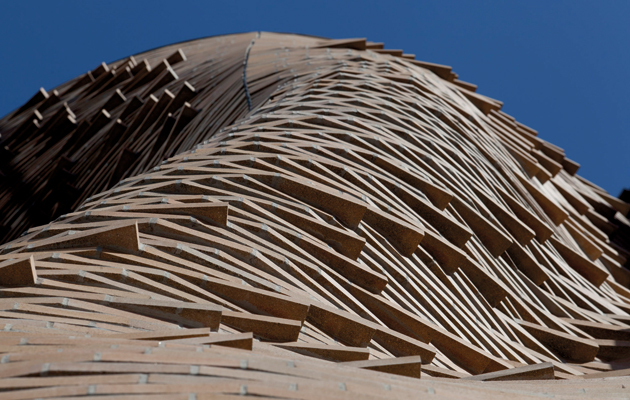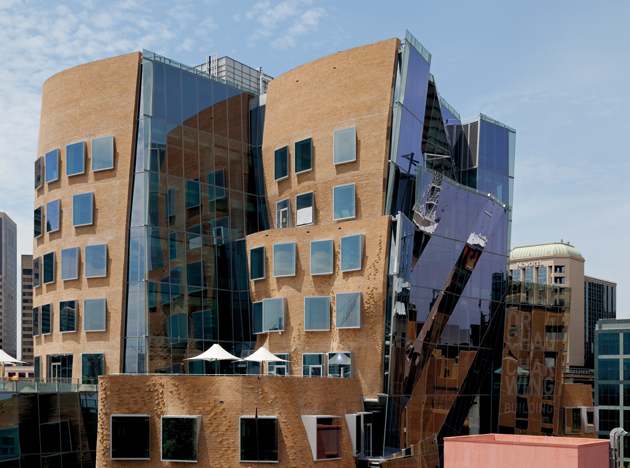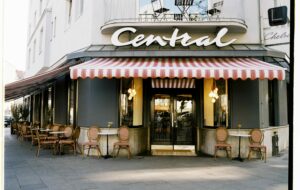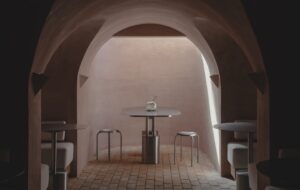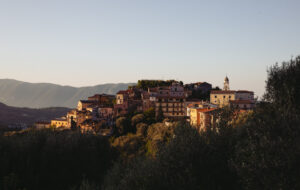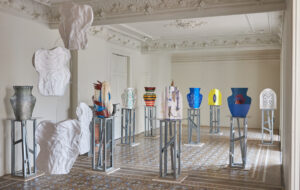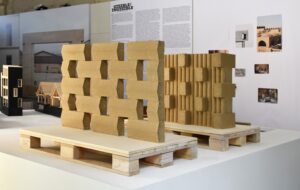|
|
||
|
At 85, Gehry has completed one of his finest buildings, the Dr Chau Chak Wing facility in Sydney. In laconic mood, the architect talks candidly to Edwin Heathcote about the role of art in his work, the dangers of architectural egotism, and why he used to think Frank Lloyd Wright was a fascist Frank Gehry is wearing a suit and a tie. It looks a little odd. I’ve never seen him in anything other than a T-shirt and a slouchy jacket. “It’s a one-time thing,” he says, adjusting the tie. “Enjoy it now, tomorrow it’ll be gone.” The garb is in homage to the setting – a business school – and the inevitable corporate milieu that accompanies it. But this is not the dull box of the typical corporate institution. Instead, it is an undulating, crumpled brick building that looks like it’s been caught mid-collapse during a particularly severe earthquake. Or, perhaps, as locals relish in describing it, like a crumpled brown paper bag. It is an astonishing structure, one that recalls the structural bravura of Félix Candela, perhaps even Gaudí. It has an exuberance and a sense of movement and restlessness that also recall the finest of Gehry’s own work. Opening soon after the huge, operatic and overblown Fondation Louis Vuitton in Paris’s Bois de Boulogne, it comes as a bit of a relief. Where the latter appears to have been a building without a brief – a glass folly in a park, in which the confluence of corporate money, bad art, big egos and a seemingly unlimited budget makes the whole thing a little unsettling – the Dr Chau Chak Wing building at Sydney’s University of Technology feels like a piece of real city. It’s a building that imbibes the brick context of industrial and educational buildings and digests them, along with the global anonymity of the glass towers in the adjacent central business district, to throw up a solid, surprising and original structure that anchors the creative quarter emerging along Sydney’s slightly anaemic version of the High Line, the “Goods Line”. |
Words Edwin Heathcote
Portrait Rohit Chawla |
|
|
||
|
The Dr Chau Chak Wing building at the University of Technology, Sydney, which opened in February 2015 |
||
|
Gehry is obviously pleased with it, as are the assembled press, business types, academics and city boosters. And, despite the suit, he looks comfortable, more sprightly than I’ve seen him in recent years, and good for 85. As we’re in Sydney, I can’t help asking him about the Opera House. The “Bilbao Effect” might be named in honour of Gehry’s Guggenheim, but I always had the impression that it was Sydney that started it. I asked him if he saw Utzon’s troubled masterpiece as a precursor in any way to Bilbao’s cool, titanium-clad curves. “That was the brief,” he replies. “Bilbao asked me to build a Sydney Opera House. ‘No fucking way!’ I said.” But he did it anyway, creating a waterside wonder that became the definitive cultural blockbuster of the second fin de siècle. Gehry is a remarkable character. He has pushed architecture in extraordinary directions, first with his ad hoc, junkyard aesthetic, then with a grand, deconstructed urban PoMo, and finally with the baroque scrunching that has become his trademark. On top of that, he pioneered the use of digital modelling and the integration of drawings and construction information. Yet, despite pushing the boundaries for more than five decades, he has never sought to justify his designs. Unlike the handful of other star names in architecture, Gehry has remained resolutely low-brow in his dialogue. He prefers to talk about ice hockey than influences. I’d always found this a little frustrating so this time I was determined to push him on the subject. Why, I asked, does he not engage with theory – how about the intellectual justification of buildings that look as extraordinary as his do? He winces slightly. “I don’t have any of that. The words don’t work. How do you explain a great party?” he says, turning the question back at me. “For me to make up a pseudo-scholarly story that makes it sound like I know something … Look, the more open-ended I leave it, the better.” |
||
|
The west-facing elevation has an angular glazed facade |
||
|
Yet, I suggest, even if he’s unwilling to talk about architectural influences and precedents, he’s often happy to talk about the influence of art, even obscure art. He once spoke to me in effusive tones about Claus Sluter, the 14th-century sculptor whose drapes and curves prefigure the Renaissance. “Well,” he replies, “art interests me. In the case of Sluter, an art historian took me to Dijon to see the asylum with a Sluter fountain [The Well of Moses]. It’s pre-Leonardo yet filled with feeling transmitted from 500 years ago. And when I visited Delphi and looked at an ‘artist unknown’ sculpture, it brought tears to my eyes. No identifiable maker. You want to reach back in time and grab them. I think all my years as an architect, the idea of the architect being an artist has been beaten out of the profession. But I think it is an art and probably we should start owning up to it and take more pride in personal expression.” Isn’t that the way to untrammelled ego? “We should be proud of our art,” he says, “but not proclaim ourselves … er … King Kong.” “When I grew up,” he continues, I think by way of clarification, “Frank Lloyd Wright was still alive. I turned down the opportunity of meeting Wright three times. I thought he was a fascist. But I was stupid and missed something I shouldn’t have missed.” Was Wright an artist? “The best of us are kinds of artists, working as artists, Giotto, Michelangelo …” Like sculptors, I ask? Or in some other way? “When we were doing the Beekman Tower [8 Spruce Street, New York], I asked the girl, the architect who was working on the designs in my office, ‘Do you know the difference between Bernini folds and Michelangelo folds?’ She said she did. Do you know the difference?” I do, as it happens (sometimes I surprise even myself). “Bernini folds are sharper,” he says. “Think of The Ecstasy of Saint Teresa. She did know the difference – and that was the design.”How about his contemporaries, I ask. “There are a lot of people practicing architecture who I truly respect,” he says. “I can’t say I like everything they do. But then I can’t say I like everything I do! But I respect that they try to create more than banality.” |
||
|
The structure contains 320,000 custom-designed bricks |
||
|
I can’t help but mention his famous finger. When faced with criticism at a press conference for the Fondation Louis Vuitton last year, he grumpily raised a digit at journalists, before complaining that “98 per cent of modern architecture is pure shit”. So why criticise architects? I know he detests the term “starchitect” so I ask him about it. “There are maybe 30 people like that. The word is unfortunate. For better or for worse, I think the Pritzker is the inspiration here – it’s given people the chance to do things. The hardest thing, though, is to stay in that position.” So how do you stay there, I ask. “The only reason to do something is if it brings added value, here, in the public space,” he says, rather avoiding the question. “Bilbao earned something like €3 billion for the city. You can see the change – it even changed politics. They named a bridge after me.” He pauses. “They didn’t ask me to design it though,” he adds. His timing is good, laconic stand-up style. “It feels good. I don’t know how to say this. A lot of my friends built things around me. Some were too respectful. Some were too competitive. Maybe I’ve grown up.” I’m not entirely sure what he means, so I change the subject. I’d heard his son, Sam, is building him a house. As his current home, the famous ad hoc construction of junkyard parts and DIY materials, is one of the great houses of the modern age, I prod him about it. “Yes,” he says, “my son’s designing it. He’s been in the office for eight years but refuses to go to school. So we had to give him a job. The first house was about finding myself in a land of denial of the world we were in.” He goes on to talk about the world of movement, of cars and freeways, of constant change while building remained static. “I knew I was never going to get the craftsmanship I got with [Victor] Gruen [the pioneering Austrian-born mall architect for whom Gehry was working in the 1950s]. We were friends with Rauschenberg, Judd, Smithson – they were re-using things, beer cans, plywood, rocks, Matta-Clark was tearing buildings down. And I didn’t have any money.” |
||
|
The facade offers distorted reflections of surrounding buildings |
||
|
Once he starts talking about art he becomes animated, so I nudge him to continue. “I think my colleagues weren’t involved in the art scene. I studied art and was going to the galleries. But I didn’t get work out of it, like they do now. It was an ethic, a questioning, a curiosity … hands on. Now a lot of artists have factories. At that time it was more raw, more energising – less precious.” “I bought a plank from John McCracken [the minimalist artist]. A plank, leaned against a wall for twelve hundred bucks. I’ve still got it and I’ve been offered a million for it. Now people treat art as a business. We’ll probably end up giving it to a museum. I feel almost embarrassed for this plank.” As we stand to wrap up, a lean, rangy character approaches Gehry and starts chatting. He pulls up his sleeve to reveal a big tattoo of the brick bonds developed for the Dr Chau Chak Wing building that we’re sitting in. The facade system is inscribed on his forearm. He asks Gehry to sign a brick, which he does, and then pose for a photo. Gehry turns for the camera and grips the brickie’s arm, holding it up so a rank of photographers can get a good shot of the tat. “Quick,” he says, grinning hard, “I’m choking off his supply of blood here.” He’s done his job. He’s the unpretentious, regular Joe, a star who can still josh with the brickies. He may have given the press the finger, but, it seems, the rest of the world still loves him. Read about Frank Gehry’s Louis Vuitton foundation building This article first appeared in our Studios issue, which also features interviews with Inga Sempe, David Adjaye and Michael Young |
||





